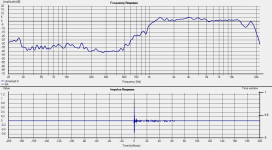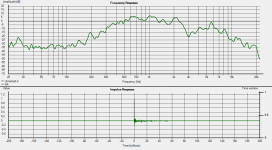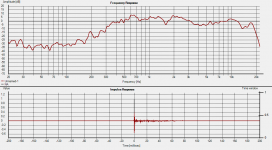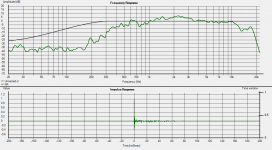Here are some quick ( and not technical) measurements. This was done in living room, no mic stand, etc. Just a quick look at what I was listening to.
Measurements are as follow:
1. Just the CD in horn
2. The mids alone
3. CD crossed with 2.2mfd cap, mids fullrange, 1 small triangle of foam placed in horn behind the mid ports and before the CD .
I am just messing around with this build. I have plans to really build a Unity Horn at some point. I was thinking I could build a portable party speaker with this test unit? It does not sound bad right now.
Steve
Measurements are as follow:
1. Just the CD in horn
2. The mids alone
3. CD crossed with 2.2mfd cap, mids fullrange, 1 small triangle of foam placed in horn behind the mid ports and before the CD .
I am just messing around with this build. I have plans to really build a Unity Horn at some point. I was thinking I could build a portable party speaker with this test unit? It does not sound bad right now.
Steve
Attachments
Last edited:
I found this thread a week ago and spent most of my free time reading.
I'm at page 84 now, still a long way to go...
Quick questions... I have some TAD4001s, are there any issues using this on a 2 way synergy horn from 600hz and up?
Any driver suggestions that would cover 80-600hz?
I'm thinking maybe an 8-12" as I have about 5.6" from the throat for the ports for 600hz XO.
A 90x60 coverage (about 3foot wide) should do it.
More info...
I have a unity/synergy horn already but would like to try more horizontal coverage. I had it right against the side wall before on my skinnier room, sounded best to me without the side wall reflections.
Now my new room is wider and I can't place it against the side wall to maintain the toe in needed.
Thanks for your help.
Jeff
I'm at page 84 now, still a long way to go...
Quick questions... I have some TAD4001s, are there any issues using this on a 2 way synergy horn from 600hz and up?
Any driver suggestions that would cover 80-600hz?
I'm thinking maybe an 8-12" as I have about 5.6" from the throat for the ports for 600hz XO.
A 90x60 coverage (about 3foot wide) should do it.
More info...
I have a unity/synergy horn already but would like to try more horizontal coverage. I had it right against the side wall before on my skinnier room, sounded best to me without the side wall reflections.
Now my new room is wider and I can't place it against the side wall to maintain the toe in needed.
Thanks for your help.
Jeff
JLH... I have never heard the SM60F in person. Do you think the molded synergy is better for home use than the regular synergy?
I do have the SH50, been living with a pair for 7-8 years
and not a thought about upgrading until I recently moved the system to a wider room.
I do have the SH50, been living with a pair for 7-8 years
and not a thought about upgrading until I recently moved the system to a wider room.
Last edited:
There are several people that are using them in HT setups. The smaller SM60F still has more output than what is needed in the home. THe SM60F is also a little more refined than a 7 or 8 year old SH50. Even the SH50 has under gone some refinement in the last couple years.
To get back to your original question, 2" format compression drivers are not ideal for a Synergy project. If you read the Synergy Patent and understand the relationship betwen where the mids have to tap into the horn in relation to the cross sectional area of the horn, the large format compression driver puts you at a disadvantage. Using 1" compression drivers makes things much easier - not to say there is anything easy about trying to build a Synergy horn.
To get back to your original question, 2" format compression drivers are not ideal for a Synergy project. If you read the Synergy Patent and understand the relationship betwen where the mids have to tap into the horn in relation to the cross sectional area of the horn, the large format compression driver puts you at a disadvantage. Using 1" compression drivers makes things much easier - not to say there is anything easy about trying to build a Synergy horn.
Thanks JLH for saving me some of the work and headaches.
I don't have the funds right now to buy another Danley horn.
That's why I was planning of going DIY.
I can live with the SH50's a for a few more years I guess
and the narrow coverage is not that bad.
Please share... what refinements were done to the SH50?
Maybe an upgrade is cheaper, if possible.
Thank you
I don't have the funds right now to buy another Danley horn.
That's why I was planning of going DIY.
I can live with the SH50's a for a few more years I guess
and the narrow coverage is not that bad.
Please share... what refinements were done to the SH50?
Maybe an upgrade is cheaper, if possible.
Thank you
I figured I would dump random Unity horn build info in this thread. Nothing I am doing warrants another thread on the subject, and really this was most of where I have read about Unity Horn information.
Here is what I have going on:
B&C DE10: B&C DE10-8 1" Mylar Horn Compression Driver 8 Ohm 2-Bolt | 294-600
Cheap $5 Horn from MCM
Part Express buyout mids: 4" Paper Cone Sealed Back Midrange Speaker A0100008FP09IA | 289-135
So slap them together and it is actually not to bad sounding!
Not much math going on here. I tried to get the mids and CD as close as I could. The mids are not sealed very well, and the whole thing is just tossed together with hot glue right now. The mids have a FS of 900hz. I would like to coat the cones and try to lower the FS some.
^^^ THIS. Right here.
This is what I keep talking about on this thread : you can get results without a lot of effort. The devil is in the details, but you can get 90% of the way there with very very little effort or money.
JLH... I have never heard the SM60F in person. Do you think the molded synergy is better for home use than the regular synergy?
I do have the SH50, been living with a pair for 7-8 years
and not a thought about upgrading until I recently moved the system to a wider room.
I have Synergy horns in my car, and yesterday I turned them into an ambiopole. This worked really nice. Here's why:
My reference speakers are constant directivity. Due to this, if you space them far apart, you can get a 'hole' in the middle. Direct radiators don't do this, due to their wider directivity.
But when you do an Ambiopole with Synergy horns, you can use the narrow directivity to your advantage. Basically the SH-50 controls directivity down to 450hz, so if you put them right in front of you, literally touching each other, you just made an ambiopole.
Choueiri(sp?) at Princeton uses constant directivity speakers for this very reason. IMHO, the Synergy does this trick better, and I think that's because it's phase is flatter.
Give it a try! You might like it. And again, due to their narrow directivity, you could likely do an ambiopole with zero processing. Just put the two speakers right next to each other, and make sure you're *exactly* between the two. No joke, if you're off by even one inch you won't hear the full effect.
Best explanation I've seen is in Choeuri's video here: https://jawbone.com/liveaudio
Last edited:
Please share... what refinements were done to the SH50?
Maybe an upgrade is cheaper, if possible.
Thank you
Minor changes to the driver T/S parameters, crossover, and port geometry. It's still a SH50, but I don't believe there is an upgrade path using any part of your existing horns. Synergy horns are a tuned system; change one thing and the other parts no longer work as intended.
PB... Ambiopole looks interesting, I'll have to check it out. Thanks
JLH... too bad about the no upgrade path for older SH.
If I had the funds I'd just go with the SH46, FR is a lot smoother
than the SH50 and at 106dB it would be perfect for my 300B and 45s 🙂
JLH... too bad about the no upgrade path for older SH.
If I had the funds I'd just go with the SH46, FR is a lot smoother
than the SH50 and at 106dB it would be perfect for my 300B and 45s 🙂
With open back mids with low Fs even if the driver is sealed the Fb is not high enough. Another way of increasing the Fb is to use a few drops of cynoacrylate glue on the driver spider which will raise driver Fs without affecting the cone mass much. By trial and error one could arrive at a driver Fs that results in the needed higher Fb.
JLH mentioned a problem with foam/rubber surround drivers.
It may alleviate this problem too due to a stiffer suspension, in this case the stiffness comes more from spider rather than the surround.
Any thoughts?
JLH mentioned a problem with foam/rubber surround drivers.
The rubber and foam surrounds are too compliant. You will never have a suspension "blowout", but under pressure they do deform. This will allow the cone to tilt and lead to voice coil rubbing.
It may alleviate this problem too due to a stiffer suspension, in this case the stiffness comes more from spider rather than the surround.
Any thoughts?
I received an email with the following questions, thought I'd post my reply in the thread.
Ive been reading many of the threads you are actively contributing to involving the synergy/unity style horns and was wondering if you would share your experiences with the numerous mids you have tried.
Sealed back vs open.
Paper vs aluminum cones
2" vs 4",5" or 6"
IMHO, a sealed 5" like the Pyle PDMR5 gives the best results for the least cost and effort. I have used 3" and 2" drivers, but that's mostly to reduce the size of the package and to increase the crossover point a little bit. If the size of the horn isn't a concern, I think the 4" and 5" sealed back drivers are the way to go.
The aluminum coned drivers sound a little less 'strident' to me than the paper cones. But it's hard to find an aluminum coned driver that will work, as the mms has to be really low for it to work on a Synergy horn. (See GM's post from page one of this thread, something like seven years ago.)
Open backed drivers severely limit your bandwidth, but I think they sound a little bit more "open" to me. Similar to the difference between listening to a dipole midrange and a sealed back midrange. The dipole sounds more "open."
If I were going to do a complete assault on the problem, I'd probably use a quad of the Dayton ND91 aluminum coned drivers in a cardioid. The Dayton combines a bunch of 'nice' elements:
1) shorting cap to reduce distortion
2) high excursion, high displacement
3) aluminum cone, which seems to behave well under the high compression ratios imposed by a Synergy horn
4) a cone that's small enough to allow for a high xover, while big enough to move a lot of air
Having said all that, the Pyle PDMR5 will give you a wider bandwidth, it's cheaper, and it's easier to get right
Ive been reading many of the threads you are actively contributing to involving the synergy/unity style horns and was wondering if you would share your experiences with the numerous mids you have tried.
Sealed back vs open.
Paper vs aluminum cones
2" vs 4",5" or 6"
IMHO, a sealed 5" like the Pyle PDMR5 gives the best results for the least cost and effort. I have used 3" and 2" drivers, but that's mostly to reduce the size of the package and to increase the crossover point a little bit. If the size of the horn isn't a concern, I think the 4" and 5" sealed back drivers are the way to go.
The aluminum coned drivers sound a little less 'strident' to me than the paper cones. But it's hard to find an aluminum coned driver that will work, as the mms has to be really low for it to work on a Synergy horn. (See GM's post from page one of this thread, something like seven years ago.)
Open backed drivers severely limit your bandwidth, but I think they sound a little bit more "open" to me. Similar to the difference between listening to a dipole midrange and a sealed back midrange. The dipole sounds more "open."
If I were going to do a complete assault on the problem, I'd probably use a quad of the Dayton ND91 aluminum coned drivers in a cardioid. The Dayton combines a bunch of 'nice' elements:
1) shorting cap to reduce distortion
2) high excursion, high displacement
3) aluminum cone, which seems to behave well under the high compression ratios imposed by a Synergy horn
4) a cone that's small enough to allow for a high xover, while big enough to move a lot of air
Having said all that, the Pyle PDMR5 will give you a wider bandwidth, it's cheaper, and it's easier to get right
Hey PB thanks for the intro to Ambiophonics.
Never heard of it until your post.
As per your suggestion I tried it and I'm very happy with the results.
The only drawback is the big speakers sitting in the middle of the room,
but it's worth the compromise.
Well... the wife has not said anything yet 🙂
Never heard of it until your post.
As per your suggestion I tried it and I'm very happy with the results.
The only drawback is the big speakers sitting in the middle of the room,
but it's worth the compromise.
Well... the wife has not said anything yet 🙂
Mids response at various point in the horn
Hi,
I am building a Synergy prototpye and measuring the mids. I see a lot of difference in the nature of the freq response curve when I measure the mids at
a) the port
vs
b) further down the horn ie towards the mouth.
Can someone point me to measurements of mids at various points in the horn?
Thanks,
Goldy
Hi,
I am building a Synergy prototpye and measuring the mids. I see a lot of difference in the nature of the freq response curve when I measure the mids at
a) the port
vs
b) further down the horn ie towards the mouth.
Can someone point me to measurements of mids at various points in the horn?
Thanks,
Goldy
I can't think of any good reason to measure the midranges at the port
I always measure at least one meter away from the speaker
I notice Danley measures at something like ten meters, but I can't do that without getting evicted (it appears Danley puts his Synergy horns up in the air using a lift, and measures in his parking lot. Just a guess, based on pics from his FB page.)
Some of these wavelengths can't even FIT in the horn, so the response inside of the horn will be different than the response at one meter. This isn't a defect, this is a feature, it contributes to the excellent phase response
I always measure at least one meter away from the speaker
I notice Danley measures at something like ten meters, but I can't do that without getting evicted (it appears Danley puts his Synergy horns up in the air using a lift, and measures in his parking lot. Just a guess, based on pics from his FB page.)
Some of these wavelengths can't even FIT in the horn, so the response inside of the horn will be different than the response at one meter. This isn't a defect, this is a feature, it contributes to the excellent phase response
Ways to extend the mids lower
I tried a 3" mid (sealed back), just one, in a test horn. I got usable response from 1200hz to 350hz (the usual peak and steep rolloff at both the ends). I wanted to extend the response lower to about 150hz so that I could xover at 200hz to woofers.
I intend to make the following changes:-
1) Use a bigger mid, say 5.25" driver (4 per horn)
2) Use the mid in a 6th order alignment instead of 4th order. Ie, place the front port into the horn as usual but put the rear ports outside the horn. Tune the rear chamber/port around 150hz or maybe a bit more lower.
Initially, it may seem as a bad idea since putting the ports outside the horn is against the 'Synergy horn point source idea' but given that the rear port covers only an octave (atmost) and the port IS covering the Schroeder freq, it may not be bad in home listening situation.
I wanted to try the 6th order alignment with 3" mids first. What do you think, is it worth?
I tried a 3" mid (sealed back), just one, in a test horn. I got usable response from 1200hz to 350hz (the usual peak and steep rolloff at both the ends). I wanted to extend the response lower to about 150hz so that I could xover at 200hz to woofers.
I intend to make the following changes:-
1) Use a bigger mid, say 5.25" driver (4 per horn)
2) Use the mid in a 6th order alignment instead of 4th order. Ie, place the front port into the horn as usual but put the rear ports outside the horn. Tune the rear chamber/port around 150hz or maybe a bit more lower.
Initially, it may seem as a bad idea since putting the ports outside the horn is against the 'Synergy horn point source idea' but given that the rear port covers only an octave (atmost) and the port IS covering the Schroeder freq, it may not be bad in home listening situation.
I wanted to try the 6th order alignment with 3" mids first. What do you think, is it worth?
Last edited:
Using a dual reflex bandpass for the midranges is tempting. Theoretically, you should be able to widen the bandwidth.
But no matter how hard I tried in Hornresp, I was never able to come up with a viable design.
This doesn't mean that it is impossible; just means that I couldn't do it. And in the real world, you may be able to tweak it by hand.
Having said that, here's some food for thought:
With four of the 5" Pyle Woofers (PDMR5 iirc), you have as much cone area as a 10" woofer. Due to the massive cone area, and high efficiency, you may be able to simply EQ it down an octave. IE, apply a liberal dose of EQ to lower the F3 of the horn from 350hz to 175hz or so.
Now, it WILL be a lot of EQ. Something like 24dB. And you won't get it down to 100hz; that would require something like 36dB, which isn't realistic.
Basically you have SO MUCH output, this might work. IE, you wouldn't want to apply 24dB of EQ to a woofer with an efficiency of 85dB, but we're talking about an array with an efficiency in the low hundreds, and with significant displacement too. It might work.
But no matter how hard I tried in Hornresp, I was never able to come up with a viable design.
This doesn't mean that it is impossible; just means that I couldn't do it. And in the real world, you may be able to tweak it by hand.
Having said that, here's some food for thought:
With four of the 5" Pyle Woofers (PDMR5 iirc), you have as much cone area as a 10" woofer. Due to the massive cone area, and high efficiency, you may be able to simply EQ it down an octave. IE, apply a liberal dose of EQ to lower the F3 of the horn from 350hz to 175hz or so.
Now, it WILL be a lot of EQ. Something like 24dB. And you won't get it down to 100hz; that would require something like 36dB, which isn't realistic.
Basically you have SO MUCH output, this might work. IE, you wouldn't want to apply 24dB of EQ to a woofer with an efficiency of 85dB, but we're talking about an array with an efficiency in the low hundreds, and with significant displacement too. It might work.
Thanks for your reply. I have a doubt though. In case of usual 6th order mid, the rear chamber is tapped inside the horn at a further distance down the horn so the lows are further away from the CD. If Eq is used with 4th order mid, then the entire lower octave is produced by the ports that are close to the CD. Isnt that too much for the CD to handle?
Also my final horn will be a circular mouth (conical) profile which is already a step back from the rectangular Synergy. I saw PSE-144 breaking the rule by having an elliptical mouth so thought a circular will also work. If I Eq its even more a step back. What do you think, do you still suggest Eq?
Also my final horn will be a circular mouth (conical) profile which is already a step back from the rectangular Synergy. I saw PSE-144 breaking the rule by having an elliptical mouth so thought a circular will also work. If I Eq its even more a step back. What do you think, do you still suggest Eq?
- Home
- Loudspeakers
- Multi-Way
- Suitable midrange cone, for bandpass mid in Unity horn



